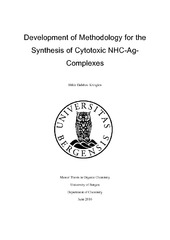| dc.description.abstract | Recently disclosed silver N-heterocyclic carbene complexes holding 4-alkylated imidazoles have been proved to hold cytotoxic properties. In this work, derivatives of such alkylated imidazoles were synthesised to be complexed with silver(I). N,N-diphenyl-4-methylimidazolium teterafluoroborate was synthesised by means of a two step synthetic pathway. The synthesis involved a selective N1-arylation of 4-methyl-1H- imidazole using the palladium-catalysed Buchwald N-arylation method, followed by a direct quaternisation using phenylboronic acid. A 2^2 factorial design was initiated to investigate how the reaction temperature and reaction time influenced the conversion of the starting material. No clear correlation was found, and a full conversion of the starting material was not obtained. The formation of the product was confirmed by LC-MS, but a successful isolation was not achieved. A N,N-diphenyl-4-heptylimidazolium tetrafluoroborate synthesis was attempted by means of a seven/eight step synthetic pathway. The synthesis involved a selective iodination of an imidazole backbone, followed by an altering of the electronic properties by the introduction of an auxiliary group. A first attempt of implementing this step using flow chemistry was successfully performed. The backbone iodide was replaced in a Sonogashira coupling reaction, in which the installed alkyne moiety was reduced using gaseous hydrogen in the presence of Pearlman's catalyst. An attempt of reducing the alkyne moiety using indium as the reducing agent was carried out, without furnishing the desired product. The palladium-catalysed Buchwald method was used to perform an N1-arylation, before phenylboronic acid was utilised in an attempt to obtain the quaternised imidazole. Only traces of the desired product were observed. It is thought that the imidazole side chain constitutes a steric hindrance that reduces the conversion of the starting material. | en_US |
